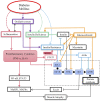Diabetic Muscular Atrophy: Molecular Mechanisms and Promising Therapies
- PMID: 35846289
- PMCID: PMC9279556
- DOI: 10.3389/fendo.2022.917113
Diabetic Muscular Atrophy: Molecular Mechanisms and Promising Therapies
Abstract
Diabetes mellitus (DM) is a typical chronic disease that can be divided into 2 types, dependent on insulin deficiency or insulin resistance. Incidences of diabetic complications gradually increase as the disease progresses. Studies in diabetes complications have mostly focused on kidney and cardiovascular diseases, as well as neuropathy. However, DM can also cause skeletal muscle atrophy. Diabetic muscular atrophy is an unrecognized diabetic complication that can lead to quadriplegia in severe cases, seriously impacting patients' quality of life. In this review, we first identify the main molecular mechanisms of muscle atrophy from the aspects of protein degradation and synthesis signaling pathways. Then, we discuss the molecular regulatory mechanisms of diabetic muscular atrophy, and outline potential drugs and treatments in terms of insulin resistance, insulin deficiency, inflammation, oxidative stress, glucocorticoids, and other factors. It is worth noting that inflammation and oxidative stress are closely related to insulin resistance and insulin deficiency in diabetic muscular atrophy. Regulating inflammation and oxidative stress may represent another very important way to treat diabetic muscular atrophy, in addition to controlling insulin signaling. Understanding the molecular regulatory mechanism of diabetic muscular atrophy could help to reveal new treatment strategies.
Keywords: diabetes mellitus; inflammation; molecular mechanism; muscle atrophy; treatment.
Copyright © 2022 Shen, Li, Wang, Qi, Liu, Wang, Ji, Chang, Deng, Xu, Shen and Sun.
Conflict of interest statement
The authors declare that the research was conducted in the absence of any commercial or financial relationships that could be construed as a potential conflict of interest.
Figures
Similar articles
-
Curcumin ameliorates skeletal muscle atrophy in type 1 diabetic mice by inhibiting protein ubiquitination.Exp Physiol. 2015 Sep;100(9):1052-63. doi: 10.1113/EP085049. Epub 2015 Aug 14. Exp Physiol. 2015. PMID: 25998196
-
Chronic kidney disease-induced muscle atrophy: Molecular mechanisms and promising therapies.Biochem Pharmacol. 2023 Feb;208:115407. doi: 10.1016/j.bcp.2022.115407. Epub 2022 Dec 31. Biochem Pharmacol. 2023. PMID: 36596414 Review.
-
Protective effects of Liuwei dihuang water extracts on diabetic muscle atrophy.Phytomedicine. 2019 Feb;53:96-106. doi: 10.1016/j.phymed.2018.09.032. Epub 2018 Sep 5. Phytomedicine. 2019. PMID: 30668418
-
Tocotrienol-rich fraction supplementation reduces hyperglycemia-induced skeletal muscle damage through regulation of insulin signaling and oxidative stress in type 2 diabetic mice.J Nutr Biochem. 2018 Jul;57:77-85. doi: 10.1016/j.jnutbio.2018.03.016. Epub 2018 Mar 21. J Nutr Biochem. 2018. PMID: 29679925
-
Potential Roles of Anti-Inflammatory Plant-Derived Bioactive Compounds Targeting Inflammation in Microvascular Complications of Diabetes.Molecules. 2022 Oct 29;27(21):7352. doi: 10.3390/molecules27217352. Molecules. 2022. PMID: 36364178 Free PMC article. Review.
Cited by
-
The Relationship between Muscle Ultrasound Parameters and Diabetic Peripheral Neuropathy among Patients with Type 2 Diabetes Mellitus: A Cross-Sectional Study.J Diabetes Res. 2023 Dec 19;2023:8897065. doi: 10.1155/2023/8897065. eCollection 2023. J Diabetes Res. 2023. PMID: 38148834 Free PMC article.
-
MCC950 Ameliorates Diabetic Muscle Atrophy in Mice by Inhibition of Pyroptosis and Its Synergistic Effect with Aerobic Exercise.Molecules. 2024 Feb 4;29(3):712. doi: 10.3390/molecules29030712. Molecules. 2024. PMID: 38338456 Free PMC article.
-
Transcriptome sequencing analysis reveals the molecular mechanism of sepsis-induced muscle atrophy.J Thorac Dis. 2024 Nov 30;16(11):7751-7770. doi: 10.21037/jtd-24-1665. Epub 2024 Nov 29. J Thorac Dis. 2024. PMID: 39678885 Free PMC article.
-
The molecular mechanism of sepsis-induced diaphragm dysfunction.J Thorac Dis. 2023 Dec 30;15(12):6831-6847. doi: 10.21037/jtd-23-1680. Epub 2023 Dec 26. J Thorac Dis. 2023. PMID: 38249924 Free PMC article.
-
Skeletal muscle myosin heavy chain expression and 3D capillary network changes in streptozotocin-induced diabetic female mice.Biomol Biomed. 2024 May 2;24(3):582-592. doi: 10.17305/bb.2023.9843. Biomol Biomed. 2024. PMID: 37902457 Free PMC article.


